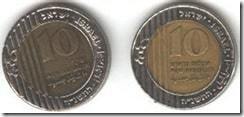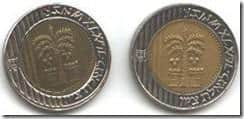These pictures of real and counterfeit Israeli 10-Shekel coins were taken by Meir Sapir in 2003. Many counterfeit coins are still in circulation.
Can you tell which ones are fake?
Image source: WBCC
Answer: The coins on the left are counterfeit. They weigh less (@morgetz said on Twitter that they feel like plastic), and the outer grooves and images are less pronounced. Sometimes the outer and inner rings are misaligned. But the most obvious difference is the text on the front of the coins: The first line of Hebrew text is shorter: It reads shekel instead of shekalim chadashim.
This doesn’t appear to be the case for all of fake coins, as seen in this photo by Jack Hepler:
Image Source: WBCC
More detailed information and telltale signs from Meir Sapir can be found in this newsletter article by Meir Sapir.
Thanks to Joy and Dena from the Survival During Hard Times mailing list for the information.
We’ve come across a few counterfeit coins over the years. It’s a good idea to examine coins you receive as change.
Here’s some good news from around the Jewish blogosphere:
Mazal tov to Aliyah by Accident on giving birth to Punja a baby boy.
Haveil Havalim is up at Dan Illouz’s blog.
Leora hosts the Kosher Cooking Carnival.
Ilana-Davita is interviewing a series of Israeli bloggers, starting with Treppenwitz, Shimshonit, and Mimi of Israeli Kitchen.
Grabbing the Chapper (Sherut): A Model of Israeli Tolerance and Cooperation



Not long ago (maybe a few months), I had a ten shekel coin returned to me by a cashier, telling me it was fake. I asked him to show me how he knew and he said “feel the coin.” Then he pulled out another coin and asked me to feel that. The counterfeit coin was smoother. Once he pointed out the difference, I could tell right away.
I still have not gotten into the habbit of checking my change, but I should.
As my daddy always says “Fool me once, shame on you. Fool me twice, shame on me.”
Thanks for the shout-out!!
Thanks for linking to me. Hope you had a great chag.